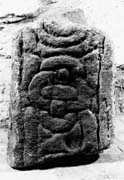Select a site alphabetically from the choices shown in the box below. Alternatively, browse sculptural examples using the Forward/Back buttons.
Chapters for this volume, along with copies of original in-text images, are available here.
Object type: Part of cross-shaft [1]
Measurements: H. 28.6 cm (11.25 in); W. 20.7 > 18 cm (8 > 7 in); D. 15 cm (6 in)
Stone type: Coarse-grained (with subangular grains and some mica), very pale brown (10YR 7/3) sandstone; see no. 1.
Plate numbers in printed volume: 542-545
Corpus volume reference: Vol 3 p. 160
(There may be more views or larger images available for this item. Click on the thumbnail image to view.)
The fragment is probably the neck of sharply tapering shaft.
A (broad): Each side has a plain edge moulding, incised at the lower end. Within the panel is a buckle-knot linked to another below which is fragmentary. At the top are three arcs of a tight spiral, now largely broken away.
B (narrow): traces of indecipherable carving, obscured by mortar.
C (broad): The plain edge moulding flanks a confused composition. At the top are irregular angular elements, and below, what may be interpreted as the head and antlers of a roughly carved stag. Over its back is a circular motif with an incised ring and a dot.
D (narrow): At the top are angular elements, some with median-incision, executed in stopped-plait technique. Below is a tight spiral scroll.
Collingwood (1911a, 286) was not right in associating the fragment with the cross-head, no. 5; the dimensions and the ornament of the two pieces do not accord. The stopped-plait compares with no. 3 (Ill. 552) and the Helmsley hogback (Ill. 478), and is a restrictedly local manifestation, though Beckermet St John 1A, in Cumbria should be compared (Bailey and Cramp 1988, ill. 52). The buckle-knot is an inexpert compromise for complicated interlace and need not be a late, degenerate form. It appears with tenth-century animal ornament on Sherburn 9 (Ill. 791), an Anglo-Scandinavian grave-cover. The iconography of the stag, if such it be, is puzzling; its closest parallel is at Forcett in the North Riding, where the stag is surmounted by a coiled snake. Collingwood continuously postulated a 'hart and hound' motif but the 'hound' is not convincing.



